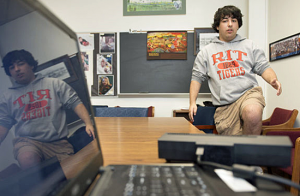A student’s concussion leads to Kinect-enabled diagnostic app
(Portions of this story first appeared in the Daily Edventures blog)
Sports-related concussions are a hot topic—not just in the National Football League, which has instituted a concussion protocol to protect injured players—but in collegiate and high school athletic departments as well. In fact, the American Academy of Pediatrics reports that concussions have risen 200 percent among teens over the past 10 years. If not promptly diagnosed and appropriately treated, these injuries can lead to permanent brain damage—an outcome that Maryland high school student Eric Solender is determined to stem.
Three years ago, when Eric was 14, he suffered a severe concussion playing basketball. “I was coming down for a rebound,” Eric recalls, “and another kid was jumping up, and his nose slammed me in the back of the head.”
The concussion was extremely serious, and Eric missed nearly a full year of school while he recuperated. His persistent symptoms, which included headaches and sensitivity to light, necessitated treatment at Children’s National Medical Center in Washington, DC. “Thanks to the doctors at Children’s, I was able to recover from it,” he says. “Now I’m trying to help people that [are] in the position that I was in.”
 High school student Eric Solender demonstrates his Kinect-enabled tool for diagnosing concussions.
High school student Eric Solender demonstrates his Kinect-enabled tool for diagnosing concussions.
That help comes in the form of a diagnostic tool that Eric coded and designed by using Kinect for Windows. The tool provides a series of tests that measure a person’s coordination and response times to certain tasks. The results of these tests can determine whether or not a concussion has occurred. The tool makes extensive use of Kinect for Windows’s body tracking capabilities, accurately measuring the user’s ability to correctly perform various coordination tasks, such as lifting his legs or raising his arms in response to specific commands.
Eric foresees the tool being used on the sidelines during athletic games and practices. “If someone gets hit in the head, the tool…can help determine the percentage chance that they have a concussion,” he explains.
As is the case with many entrepreneurs, Eric’s personal experience and passion for learning—and also for giving back—led him to where he is today. But it wasn’t easy. “I never realized how serious [concussions] were until I had one,” he says. “I have taken it upon myself to learn about them.”
Not only did Eric learn everything he could about concussion, he also taught himself how to code.
“Learning the Kinect SDK was a satisfying challenge,” he notes. “I originally started programming in Java, and then made the transition to C Sharp and C++. That was the hardest part. But once I understood the SDK, then it was…I wouldn’t say easy…but it made sense. And learning the machine learning was pretty hard, too.”
What’s next for Eric? Aside from doing what he needs to make his test available for use as an FDA-approved clinical tool, “My goal is to go to college and get a Ph.D. in computer science,” he says. “And in my undergrad [studies], I want to minor in neuroscience or neuropsychology. Something involving the brain.”
We’ll be keeping an eye out for Eric Solender. He’s already doing amazing things—we can only imagine what the future holds for him.
The Kinect for Windows Team
Key links